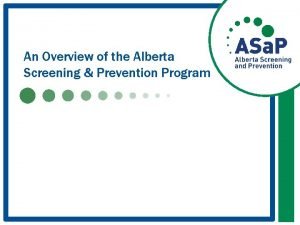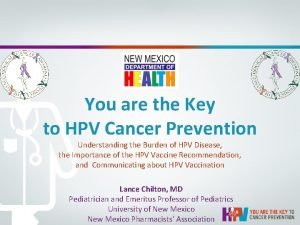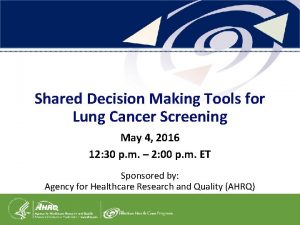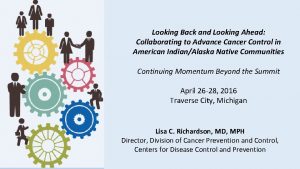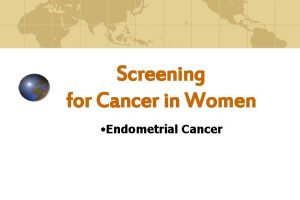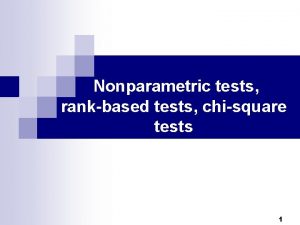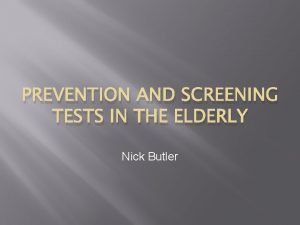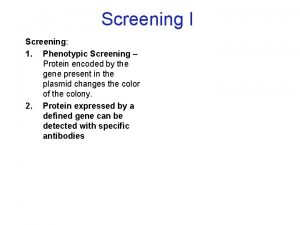Cancer Screening and Prevention Screening Tests and Selfexams

























- Slides: 25

Cancer Screening and Prevention

Screening Tests and Self-exams Screening tests: • Colon • Breast • Cervical • Prostate Self-exams: • Testicular • Skin

Why Screening Tests? The treatment of cancer is most successful when the cancer is detected as early as possible, often before symptoms occur.

Cervical Cancer Screening • The Pap test (or Pap smear) allows early Normal smear of detection of. Pap cancer the cervix • The cells are placed on a slide and sent to a laboratory, where a Abnormal Papused smear to microscope is check for abnormalities. PAP SMEAR ANIMATION: https: //www. youtube. com/watch? v=1 Jz. V 6 z 6 G 2 Rc

Cervical Cancer Screening Guidelines • Annual pap testing should begin with the onset of sexual activity or at age 18 • Investigate pros & cons of new HPV vaccine • Pap testing should continue less frequently at the discretion of the medical provider and patient after three or more annual tests have been normal

Breast Cancer Screening • Breast cancer can sometimes be detected in its early stages using a mammogram, an Xray of the breast. • If a mammogram indicates the presence of an abnormality, further tests must be done to determine whether breast cancer actually is present. Mammogram animation: https: //www. youtube. com/watch? v=z. QTw_PVzd. OQ

Breast Cancer Screening Guidelines • Yearly mammograms starting at age 40 and continuing for as long as a woman is in good health. • Clinical breast exams (CBE) should be part of a periodic health exam, about every three years for women in their 20 s and 30 s and every year for women 40 and over.

Breast Cancer Screening Guidelines • Women should report any breast change promptly to their health care providers. Breast self‑exam (BSE) is an option for women starting in their 20 s. • Women at increased risk (e. g. , family history, genetic tendency, past breast cancer ) should talk with their doctors about the benefits and limitations of starting mammography screening earlier, having additional tests (e. g. , breast ultrasound or MRI), or having more frequent exams. • Video: Self Breast Exam • https: //www. youtube. com/watch? v=e 6 wp. Onf 2 ORg

Colon Cancer • Most colon cancers start as a polyp • A polyp • Removing polyps can prevent colon cancer • Advanced bleeding cancer

Colon Cancer Screening • A procedure called a fecal occult blood test (FOBT) detects invisible amounts of blood in the feces, a possible sign of several disorders, including colon cancer. • With an application stick, a dab of a stool specimen is smeared on a chemically treated card, which is tested in a laboratory for evidence of blood.

Colon Cancer Screening • Some other options include sigmoidoscopy and colonoscopy. • sigmoidoscopy uses a lighted instrument called a sigmoidoscope to find precancerous or cancerous growths in the rectum and lower colon. • Colonoscopy uses a lighted instrument called a colonoscope to find precancerous or cancerous growths throughout the colon, including the upper part. Colonoscopy animation: https: //www. youtube. com/watch? v=XHot 6 QBx 2 JQ

Colon Cancer Screening Guidelines • Age of 50 and older; younger if there is a family history • Yearly fecal occult blood test (FOBT) or • Flexible sigmoidoscopy every 5 years or • Colonoscopy every 10 years

Prostate Cancer Screening Guidelines • Men should speak to their doctor about the pros and cons of prostate cancer screening • Both prostate specific antigen (PSA) and digital rectal examinations (DRE) are recommended for men over 50 and who choose to undergo screening for prostate cancer - PSA is a blood test that measures the level of protein produced by the prostate gland. High levels of this protein is maybe a risk factor for prostate cancer.

Testicular Cancer Screening Guidelines • Doctors agree that examination of a man’s testicles is an important part of a general physical exam. It is recommended that a testicular exam be conducted during routine cancer-related checkups. • It is believed that it is important to make men aware of testicular cancer and that any unusual mass should be evaluated by a health care provider immediately.

Skin Cancer • The ABCD’s of melanoma (skin cancer): – – A B C D Asymmetry: one half is not like the other Border: the edges are jagged or irregular Color: the color is varied, tan, red, black ect Diameter: the diameter is larger than 8 mm (the top of a pencil eraser

Skin Cancer Prevention • It is important to: – Protect your skin with hats, long sleeves and sunscreen – Do a self examination of your skin monthly – Become familiar with any moles, freckles or other abnormalities on your skin – Check for changes once a month. Show any suspicious or changing areas to your health care provider.

Biopsy Pathology • To diagnose the presence of cancer, a doctor must look at a sample of the affected tissue. Proteomic underprofile the microscope • If any test indicate the possible existence of cancer, a doctor must then. Patient’s perform a biopsy, which is the tissue sample or Genomic profile surgical removal blood of asample small piece of tissue for microscopic examination.

Biopsy • This microscopic examination will tell the doctor whether a tumor is actually present and, if so, Pathology (i. e. , whether it is malignant cancer) or benign. • In addition, microarrays may be used to determine Proteomic profile which genes are turned on or off in the sample, or proteomic profiles may be collected for an analysis of Patient’s tissue sample or protein activity. Genomic profile blood sample

How Far Have We Come ? Five year survival rate: • 1913 - 10% • 2003 - 66% • Advances in cancer research continue

Fruits and Vegetables Decrease Cancer Risks • Cancer rates could decline by up to 20% if everyone consumed 5 fruits and vegetables a day!* • Cancer fighting substances: *American Institute for Cancer Research, 1998. – – Antioxidants Dietary fiber Carotenoids Flavenoids

Limit Alcohol to No More Than • Men – 2 drinks per day • Women - 1 drink per day

Reduce Your Skin Exposure to the Sun § § § Limit time outside, between 10 a. m. & 4 p. m. Wear protective clothing. Use wide-brimmed hats and sunglasses. Prevent sunburns, especially for children under 18. Use waterproof sunscreen of SPF 15 or higher. Reapply as directed. Avoid tanning beds.

Be Active…Often • Exercise for 30 minutes or more at least 4 days a week.

Avoid Smoking or Chewing Tobacco • Cigarette smoking is the leading cause of preventable death in the US and Canada • Second hand smoke affects everyone

Tobacco Use and Cancer • Cigarette smoke contains more than two dozen different chemicals capable of causing cancer. • Cigarette smoking is the main cause of lung cancer and contributes to many other kinds of cancer as well, including cancer of the mouth, larynx, esophagus, stomach, pancreas, kidney, and bladder.
 Primary prevention secondary prevention tertiary prevention
Primary prevention secondary prevention tertiary prevention Ace different help iq tests but
Ace different help iq tests but Alberta screening and prevention program
Alberta screening and prevention program Hpv cancer prevention
Hpv cancer prevention Lung cancer screening shared decision making tool
Lung cancer screening shared decision making tool Chapter 24 the immune and lymphatic systems and cancer
Chapter 24 the immune and lymphatic systems and cancer What empties into the left subclavian vein
What empties into the left subclavian vein Shrek tests allies and enemies
Shrek tests allies and enemies Parametric and non parametric test
Parametric and non parametric test City and guilds secure assess
City and guilds secure assess Chapter 24 diagnostic tests and specimen collection
Chapter 24 diagnostic tests and specimen collection Chapter 20 more about tests and intervals
Chapter 20 more about tests and intervals Romeo and juliet act 1 test
Romeo and juliet act 1 test Analytical procedures
Analytical procedures Unit 2 friendship
Unit 2 friendship Ptm mental maths
Ptm mental maths Biochemical data, medical tests, and procedures (bd)
Biochemical data, medical tests, and procedures (bd) Physical fitness grade 9
Physical fitness grade 9 Advantages and disadvantages of projective tests
Advantages and disadvantages of projective tests Strengths of focus groups
Strengths of focus groups Family and friends tests
Family and friends tests Chapter 24 diagnostic tests and specimen collection
Chapter 24 diagnostic tests and specimen collection List and describe 3 tests of cerebellar function
List and describe 3 tests of cerebellar function Leeds pathology tests and tubes
Leeds pathology tests and tubes National breast and cervical cancer early detection program
National breast and cervical cancer early detection program National breast and cervical cancer early detection program
National breast and cervical cancer early detection program


